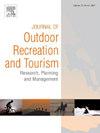休闲活动的声足迹:分析步道对野生动物声景观的影响
IF 4.4
3区 管理学
Q1 HOSPITALITY, LEISURE, SPORT & TOURISM
Journal of Outdoor Recreation and Tourism-Research Planning and Management
Pub Date : 2025-08-28
DOI:10.1016/j.jort.2025.100938
引用次数: 0
摘要
公园、保护区和其他绿地为人类提供了各种便利,也为野生动物和生物多样性提供了栖息地。然而,来自户外娱乐的人为干扰,包括噪音,会对生物多样性产生负面影响。使用被动声学监测的声景观分析提供了一种可扩展的噪音驱动因素和对娱乐小径生物多样性影响的评估。虽然有关于道路对野生动物影响的声学数据,但关于娱乐小径噪音影响的研究较少。为了解决这一问题,我们在constee自然保护区收集了声学数据并计算了声学指数,这是一个城市周边的休闲空间,以评估休闲小径上和远离小径的地点的生物声学。声学指数值在有和没有人流量的地点之间存在差异,这表明娱乐活动对野生动物、生物多样性和声学环境的影响更广泛。这些数据表明,声学监测为对步行轨道的生物多样性价值和影响感兴趣的娱乐管理者提供了可行的见解。此外,这些数据表明,步道使用管理应考虑保护野生动物和人类首选的声环境的机制。本文章由计算机程序翻译,如有差异,请以英文原文为准。
The acoustic footprint of recreation: Analyzing trail impacts on wildlife soundscapes
Parks, preserves, and other greenspaces provide diverse amenities to humans and habitats for wildlife and biodiversity. However, anthropogenic disturbances, including noise, from outdoor recreation can negatively impact biodiversity. Soundscape analyses using passive acoustic monitoring provides a scalable assessment of the drivers and impacts of noise on biodiversity along recreation trails. While there is acoustic data on the effects of roads on wildlife, there is less work on the effects of noise from recreation trails. To address this gap we collected acoustic data and calculated acoustic indices at Conestee Nature Preserve, a peri-urban recreational space, to evaluate the biophony at locations on recreational trails and away from trails. Acoustic index values differed between locations with and without foot traffic indicating an influence of recreation on the wildlife, biodiversity, and the acoustic environment more broadly. These data demonstrate that acoustic monitoring provides actionable insight for recreation managers interested in the biodiversity value and impacts of walking rails. In addition, these data suggest that trail use management should consider mechanisms to protect acoustic environments preferred by wildlife and humans.
求助全文
通过发布文献求助,成功后即可免费获取论文全文。
去求助
来源期刊

Journal of Outdoor Recreation and Tourism-Research Planning and Management
HOSPITALITY, LEISURE, SPORT & TOURISM-
CiteScore
6.70
自引率
5.30%
发文量
84
期刊介绍:
Journal of Outdoor Recreation and Tourism offers a dedicated outlet for research relevant to social sciences and natural resources. The journal publishes peer reviewed original research on all aspects of outdoor recreation planning and management, covering the entire spectrum of settings from wilderness to urban outdoor recreation opportunities. It also focuses on new products and findings in nature based tourism and park management. JORT is an interdisciplinary and transdisciplinary journal, articles may focus on any aspect of theory, method, or concept of outdoor recreation research, planning or management, and interdisciplinary work is especially welcome, and may be of a theoretical and/or a case study nature. Depending on the topic of investigation, articles may be positioned within one academic discipline, or draw from several disciplines in an integrative manner, with overarching relevance to social sciences and natural resources. JORT is international in scope and attracts scholars from all reaches of the world to facilitate the exchange of ideas. As such, the journal enhances understanding of scientific knowledge, empirical results, and practitioners'' needs. Therefore in JORT each article is accompanied by an executive summary, written by the editors or authors, highlighting the planning and management relevant aspects of the article.
 求助内容:
求助内容: 应助结果提醒方式:
应助结果提醒方式:


